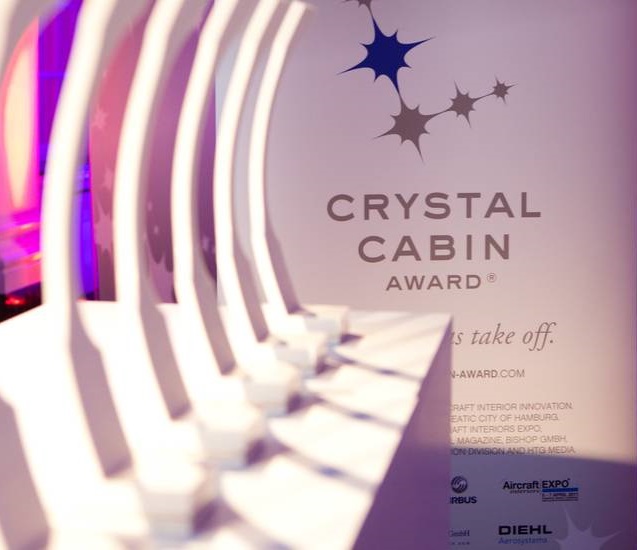21 products and ideas are in the finals of the 2017 Crystal Cabin Awards, the world’s most renowned prize for innovation in aircraft interiors.
From a parking guidance system for cabin baggage to a lavatory mirror that displays on-board video and information as if by magic, the finalists’ submissions include innovative ideas for pretty much every aspect of the cabin – revealing today how we will be flying in the world of tomorrow. In the field of “Cabin Concepts” in particular, the giants are lining up for a showdown: Bombardier, Delta Air Lines and United Airlines are all hoping for a trophy in the same category. With 85 shortlist entrants from 21 nations, the 2017 Crystal Cabin Awards have been more popular and more international than ever before in their 11 years of history.
The seven winners of the coveted Crystal Cabin Award trophies will be announced on the first evening of the Aircraft Interiors Expo (4 – 6 April, 2017) in Hamburg, Germany.
The final in the “Cabin Concepts” category this year might be more exciting than ever before: three international “heavyweights” are going head-to-head. Two of them are leading American airlines: Delta Air Lines is offering business class passengers enclosed cabin areas with privacy partitions in its “Delta One Suite” – a luxury which was until now reserved for first class passengers.
The concept is initially being implemented in Delta’s A350s. The business passenger concept from United Airlines, “Polaris”, also promises a maximum of freedom. After enjoying the exclusive Polaris Lounge with dinner service and relaxation rooms, passengers experience a new cabin configuration with all-aisle access seats in a density neutral layout, not compromising space or comfort.
Also in contention for the best cabin concept is Canadian aircraft manufacturer Bombardier with the cabin for its C Series, the first completely new short and medium-haul airliner for 30 years.
Another completely new innovation in the market this year is the “K-Reflexion Mirror” from Krüger Aviation. This finalist in the “Material & Components” category is the first plastic mirror which, thanks to its semi-transparent structure, can display safety announcements, product information and tips for the destination – in the on-board lavatory. Studio Moderna Bologna concentrates its efforts primarily on long-haul aviation seating, and its innovative, elastic material units for the aircraft seat provide a solution for the optimal distribution of body weight – almost like cushioned on clouds, above the clouds. Flexibility is the order of the day for Diehl Aircabin, and the company is tackling the typical monotonous wall surfaces in the aircraft cabin: with the help of its direct printing method, individual colours and patterns can enliven the cabin wall without the troublesome effort of removing panels.
The innovations in the “Cabin Systems” category are more in the background, but no less relevant. The “Watchdog” from Airbus addresses a problem that at first sounds absurd but in fact generates enormous costs for the aviation industry every year: accidental activation of the emergency escape chutes on the ground when crew members open the aircraft doors.
The Watchdog sensor warns whenever there is a movement near the door handle, which will enable it to reduce this expensive and dangerous source of error. Zodiac Aerospace has also come up with a sensor, but in an entirely different field: the first cabin baggage management system for overhead compartments. Similar to the green arrows in multi-storey car parks, lights above the overhead baggage lockers indicate free space for cabin baggage. The concept also includes larger space for cases, so that the finalist promises a reduction in “cabin baggage anxiety”. Diehl Aerospace, together with the Lucerne University of Applied Sciences and Arts, combines data and electricity cables with their newly developed “Power Line Communication”. This “free-loading” of data flows using existing power cabling on board results in an immense saving of materials and thereby weight.
Efficiency and sustainability are, as would be expected, also at the forefront in the “Greener Cabin, Health, Safety and Environment” category. Amongst the finalists is “GermFalcon” from the US-based company of the same name. This cleaning device for cabins uses ultraviolet C light, which removes bacteria and viruses from seats and other surfaces without the use of chemical agents.
The “Revolution Toilet” from Zodiac Aerospace also aims to fight bacteria. Not only does it consist of recycled composite fibre materials and save water, it is also merciless with germs on the toilet edge thanks to special vents. Airbus successfully pushed the ReTrolley all the way into the finals, a rubbish collection trolley allowing the crew to sort and compress waste while they pass through the cabin.
Bombardier is present at the Crystal Cabin Awards for the first time this year and already has a double entry in the finals. In the “Passenger Comfort Hardware” category, the Canadians present their concept of barrier-free toilets for their CRJ range of aircraft. They are facing off with Airbus, whose “Smart Cabin Reconfiguration” solution for moving aircraft seats on rails has also made it to the final. Past years have already seen ideas for efficient reconfiguration of seating depending on load.
The Airbus approach now promises particularly minimal effort in both the initial installation and, most importantly, crew operation, so that the rail system may be operated without any prior mechanical knowledge. An idea creating a benefit with minimal effort for the crew is what brought Diehl Comfort Modules into the finals, too: the company’s bar module can be integrated into the gallery in just a few simple steps, magically transforming the grey and boring kitchenette into a bar or a duty-free sales counter within seconds.
Inflight Entertainment and Connectivity stays a major field of growth: More and more airlines are installing wireless connectivity solutions for passengers. The “Electronic Systems” category has two finalists which showcase this development: Lufthansa Technik’s “niceview mobile” product is offering passengers a way to follow their journey with interactive maps on their personal mobile devices. Global Eagle Entertainment has submitted a complete entertainment portal, allowing passengers to surf the internet, watch films and read magazines on their smartphones. Airbus apparently found the right frequency in communicating to the Award’s 29 international jury members this year, making it to the finals in this category also (and thus being a finalist in four categories in total) with radio-based wireless communication (WAIC – Wireless Avionics Intra-Communications). Smoke detectors, lighting and temperature regulation can be controlled with a patented radio frequency – no cables are required and it is easy for the airlines to install.
It’s back again in 2017 with creative student concepts: the “University” category. Repeating its success from last year, the Delft University of Technology has more than one idea in the final: “myseat” is the equivalent of a parking guidance system for passengers, accompanying them all the way from check-in to their seat using Bluetooth technology. The idea is to achieve a structured boarding process. Meanwhile, “The Revitalisation System” turns the cabin seating upholstery into a game controller, with body movements whilst sitting controlling the on-board entertainment system. Lengthy periods in the seat become a workout. Finalist Hamburg University of Applied Sciences has given thought to the other end of the spectrum:
Independent travel for wheelchair users faces many hurdles – especially when it comes to using the on-board toilet. Thanks to its specially designed seat, the “Smart Onboard Wheelchair” from can be rolled directly over the toilet.
The seven winners of the Crystal Cabin Award 2017 will be announced during the Aircraft Interiors Expo trade fair at a gala event to be held on the evening of 4 April at the Hotel Atlantic Kempinski in Hamburg.
First, all of the finalists have to personally answer the critical and probing questions of the 29 international experts on the judging panel – airline representatives, professors, aircraft manufacturer representatives, and journalists – and present their projects in an “elevator pitch”.





Leave a Comment